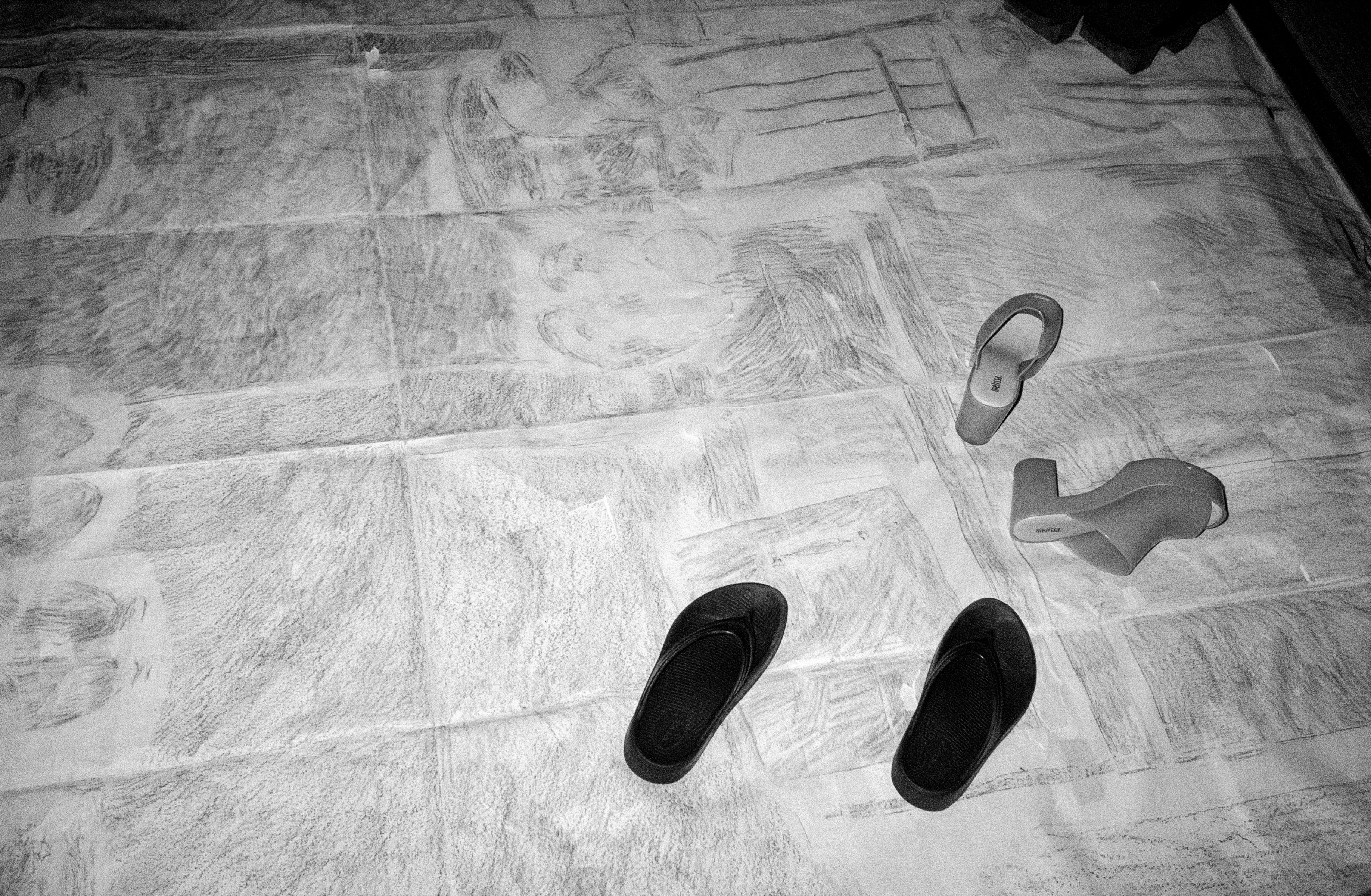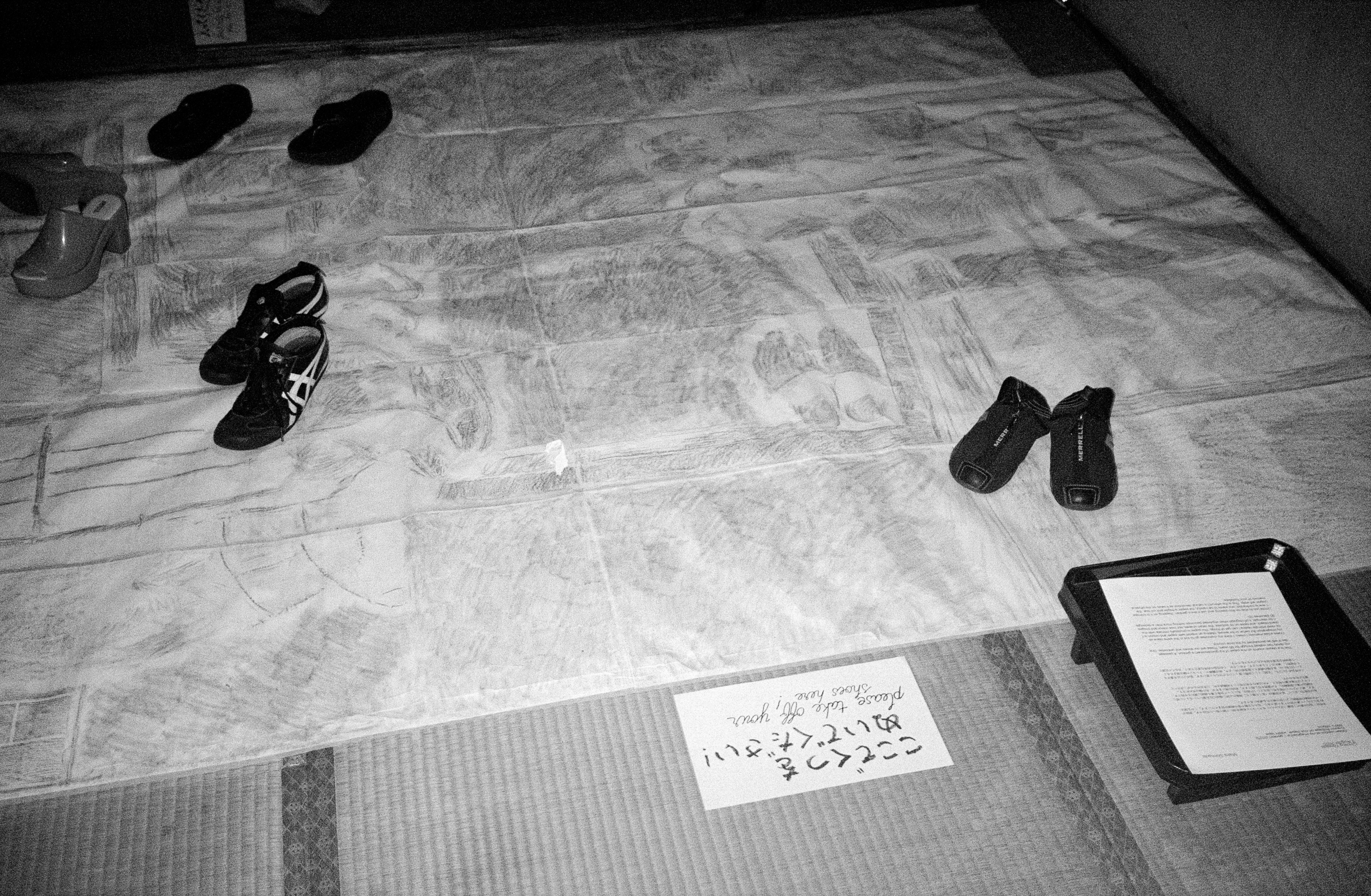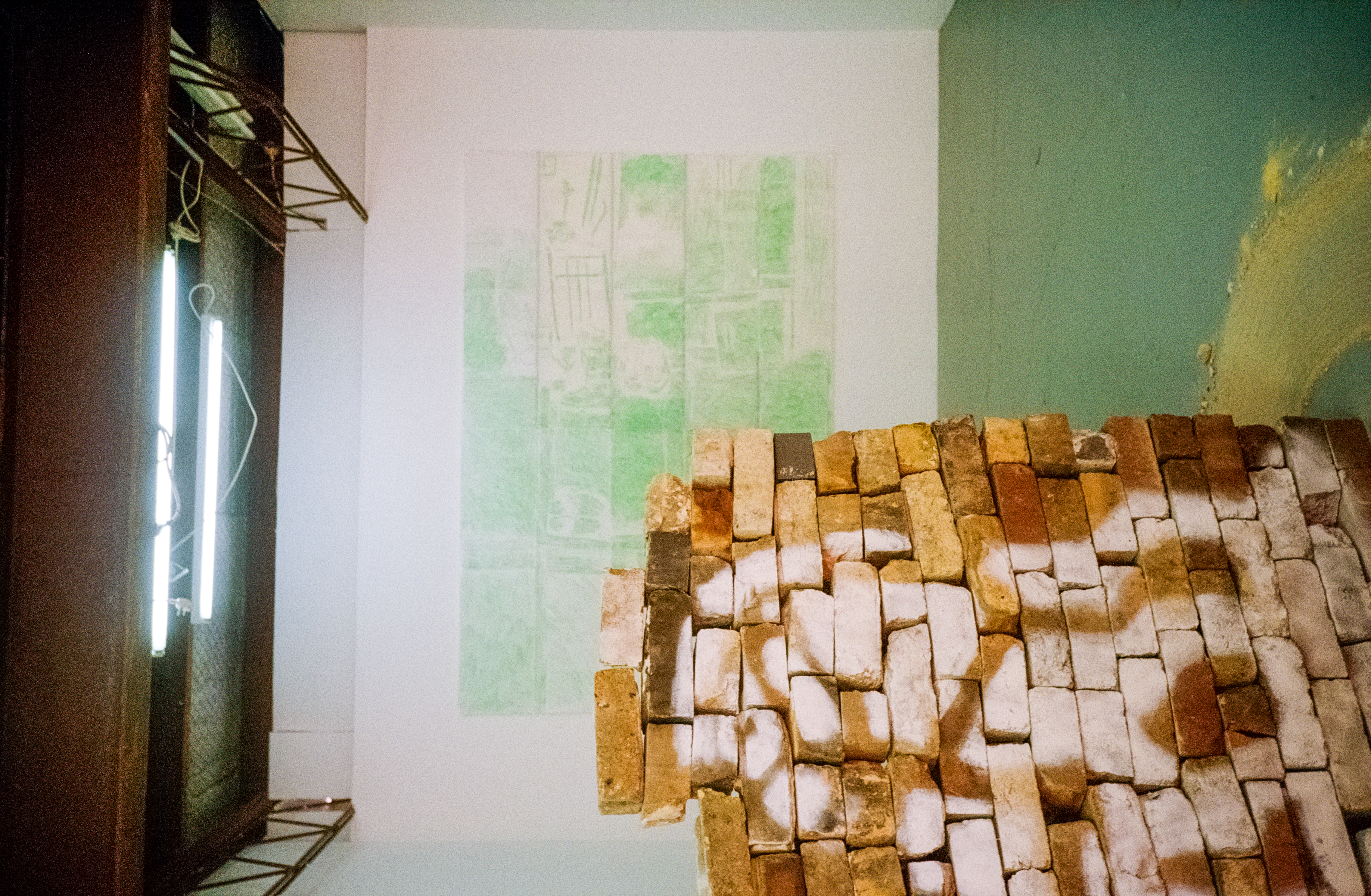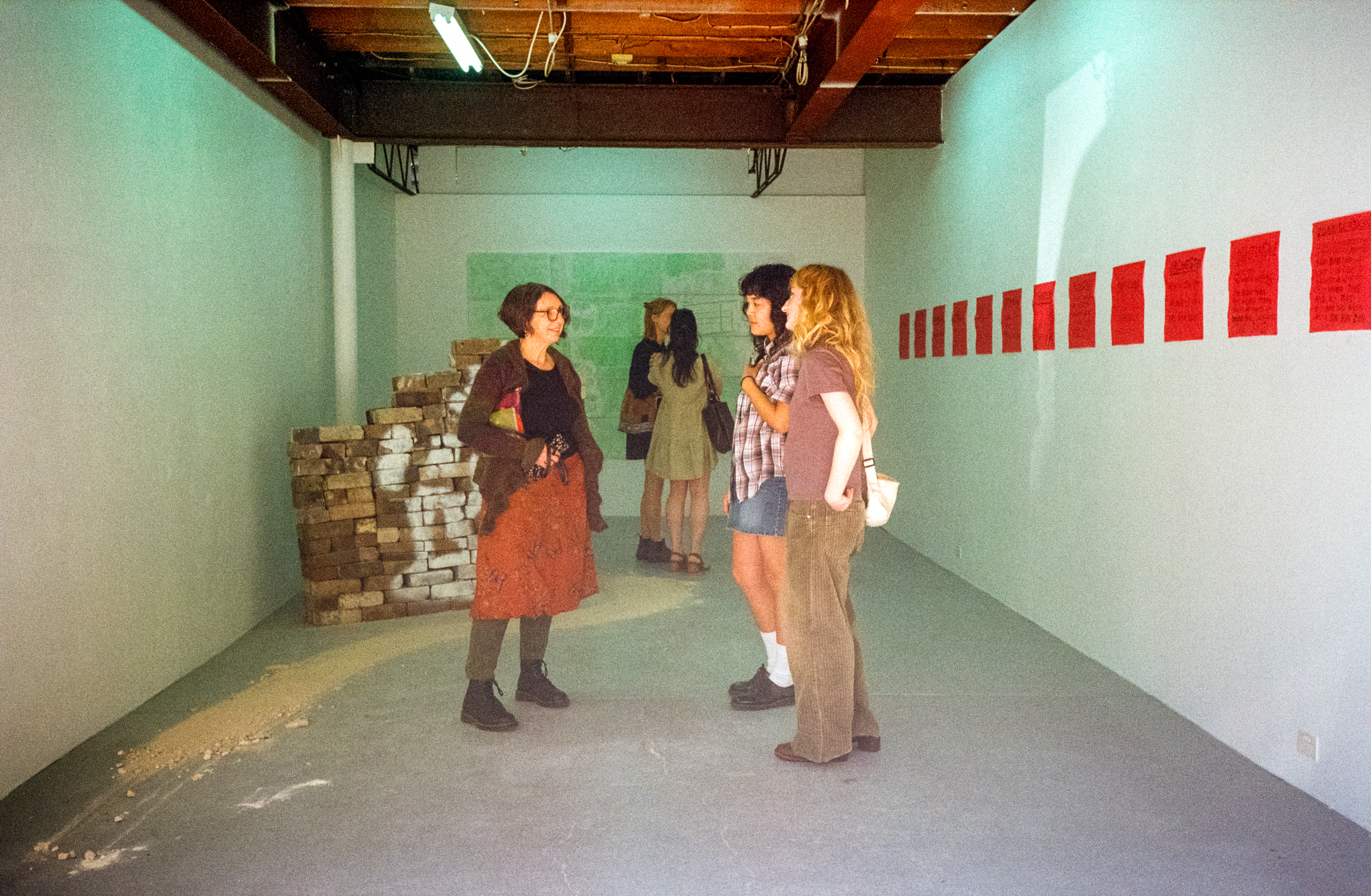Horseshoe, AIRspace Projects
Harrison Rae + Maira Shimada
“Horseshoe presents work by Harrison Rae and Maira Shimada that reflect on collapse as a destructive and generative force. Through archival reproduction and acts of deconstruction, their practices pull intimacies out of the mundane and structurally unsound.”

Green replica of my imagination / genkan (2025)
Crayon frottage on rice paper, tape. 260x165 cm.
Originally exhibited in Tokyo at HoiPoi Kōenji for “Circling Threads”, August 2025.
This is a crayon imprint on rice paper of my grandmother’s genkan (entranceway) in west Tokyo. A passage my family has walked through for 60 years. These are our shoes and umbrellas. It is scheduled for demolition by local council, some day in the next years. I keep picturing the demolition ball rocking in the sky and smashing it to a million pieces of 1960s concrete.
I have a bad memory; I mean, I think my memories go to live in the same place as my imagination (for better or for worse). Making an imprint with paper and crayon is the most intimate replica I can get of things. The paper is physically intimate with the place/object, and takes on its textures. We retain shapes, but lose colour and images – for example, a photograph when imprinted becomes nothing more than a rectangle. 3D becomes 2D.
Crayon frottage on rice paper, tape. 260x165 cm.
Originally exhibited in Tokyo at HoiPoi Kōenji for “Circling Threads”, August 2025.
This is a crayon imprint on rice paper of my grandmother’s genkan (entranceway) in west Tokyo. A passage my family has walked through for 60 years. These are our shoes and umbrellas. It is scheduled for demolition by local council, some day in the next years. I keep picturing the demolition ball rocking in the sky and smashing it to a million pieces of 1960s concrete.
I have a bad memory; I mean, I think my memories go to live in the same place as my imagination (for better or for worse). Making an imprint with paper and crayon is the most intimate replica I can get of things. The paper is physically intimate with the place/object, and takes on its textures. We retain shapes, but lose colour and images – for example, a photograph when imprinted becomes nothing more than a rectangle. 3D becomes 2D.
The first phase of exhibiting this work happened in Tokyo - it was installed on the floor of the gallery at its entrance, and I invited attendees to use it like a real genkan; please take off your shoes here to enter the gallery. In Japanese culture, stepping on something is a really degrading thing to do, a kind of compulsion that’s probably leftover from feudal times. So stepping on the work was very intimate – one is confronted, one wants to be careful, the paper is fragile and will tear, the crayon will warp. This was the artwork’s natural devolution as it took on the physical memory of their shoes and feet.
By the time I brought the work to Eora it was pretty fragile, full of long tears with a sheen of dirt in the pattern of the tatami floor of the original gallery. This time we installed it floating on the wall. It was extremely structurully unsound, the damage all there to sniff and inspect, and that waxy crayon stench still hanging around.
By the time I brought the work to Eora it was pretty fragile, full of long tears with a sheen of dirt in the pattern of the tatami floor of the original gallery. This time we installed it floating on the wall. It was extremely structurully unsound, the damage all there to sniff and inspect, and that waxy crayon stench still hanging around.











Some kind of calendar (2025)
Ink on twelve red napkins. 33x33cm each.
Earlier on Harry and I were drawn to Hito Steyerl’s work ‘November’ (2004) which paints the time following a period of revolution. Steyerl says, ‘If October is the hour of revolution, November is the time of common sense afterward, though it is also the time of madness’. We imagined September to symbolise the period prior to the October hour. Although this study eventually abstracted into the exhibition theme around ‘collapse’, the sentiment remained undercurrent to our work. We talked and worked inspired and in solidarity with the greatest political upheavals of our own lifetimes.
12 words one for each month. I play a game of making as many words as possible from each word, then making a poem from these anagrammatic words. Sometimes I need to misspell and abbreviate to make do with what letters I’ve got. Sometimes they get a sort of beat to them from all the chopping. Meanwhile the world around is a daily dissolution of humanity. In some people, and in me, there’s a sort of painful and gratifying self-governance that’s pushed out like a baby being born. How do we raise this baby? Who are its parents?
Ink on twelve red napkins. 33x33cm each.
Earlier on Harry and I were drawn to Hito Steyerl’s work ‘November’ (2004) which paints the time following a period of revolution. Steyerl says, ‘If October is the hour of revolution, November is the time of common sense afterward, though it is also the time of madness’. We imagined September to symbolise the period prior to the October hour. Although this study eventually abstracted into the exhibition theme around ‘collapse’, the sentiment remained undercurrent to our work. We talked and worked inspired and in solidarity with the greatest political upheavals of our own lifetimes.
12 words one for each month. I play a game of making as many words as possible from each word, then making a poem from these anagrammatic words. Sometimes I need to misspell and abbreviate to make do with what letters I’ve got. Sometimes they get a sort of beat to them from all the chopping. Meanwhile the world around is a daily dissolution of humanity. In some people, and in me, there’s a sort of painful and gratifying self-governance that’s pushed out like a baby being born. How do we raise this baby? Who are its parents?
There’s a form of divination in Chinese calligraphy that as a pastime I’ve played around with. All kanji are made of smaller kanji called ‘radicals’, which are the fundamental root characters. For example, the kanji for ‘island’ is made of the radicals ‘mountain’ and ‘bird’, alluding to the mountain being the place a bird will fly over and take rest on. I used to privately do divination about people I met, would take apart their names and see what meaning could be made. The napkin poems developed from this habit of taking words apart, only this time with the latin alphabet.
Napkins are flimsy, flammable, flirt with the wind. We eat off them, we wipe our mouths and tears with them.
I ended with ‘disambiguation’, a word I’ve never used, because the wikipedia page for ‘September’ is titled ‘September (disambiguation)’. It weirdly spoke to my feelings around the napkin poems wombing the biomorphic emotion of dystopia that edges into each waking and sleeping hour of the 21st century.
Napkins are flimsy, flammable, flirt with the wind. We eat off them, we wipe our mouths and tears with them.
I ended with ‘disambiguation’, a word I’ve never used, because the wikipedia page for ‘September’ is titled ‘September (disambiguation)’. It weirdly spoke to my feelings around the napkin poems wombing the biomorphic emotion of dystopia that edges into each waking and sleeping hour of the 21st century.



